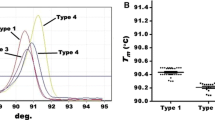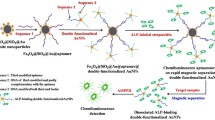Abstract
A method using non-radioactive material alkaline phosphatase to label HBV DNA as probe has been studied and used in clinical experiments to detect the HBV DNA in hepatitis serum. Alkaline phosphatase coupled with polyethyleneimine (PEI) using P-benzoquine as cross-linking reagent. The modified phosphatase was covalently linked to single strand DNA using glutraldehyde. Such single strand DNA enzyme complexes have been tested for blot hybridization, after hybridization and incubation with a substrate solution, sequences complementary to the probe can be visualized directly in 1 h. The minimum amount about 10 pg of target DNA has been detected in this way, 32P labeled probes are autoradiography 1 h after hybridization can only detect 10 ng, so the enzyme labeled probe is more sensitive than isotope labeled probe in 1 h fast test. Comparing the enzyme-labeled HBV DNA probe with 32P labeled the same one, positive proportion of detecting the HBV DNA in hepatitis patients was about 95.7%. Because the positive patient's serum detected by 32P labeled probe were selected through 1- week radiation, Alkaline Phosphatase labeled probes are color developed for only 1 h. Our experiment certified that it is a sensitive, specific, easy, rapid, safe and economical probe labeling and clinical virus DNA detection method.
Similar content being viewed by others
References
Langer P.R., et al., Proc Natl Sci USA 78, 6633, 1981.
Leary J.J., et al., Proc Natl Acad Sci USA 80, 4045, 1983.
Richardson W.R., et al., Nucl Acids Res 11, 6167, 1983.
Chu B., et al., Nucl Acids Res 11, 6513, 1985.
Kemp T.H., Nucl Acids Res 13, 45, 1985.
Singer R.H., Proc Natl Acad Sci USA 79, 7331, 1982.
Langer P.R., et al., Proc Natl Acad Sci USA 79, 4381, 1982.
Forster A.C., et al., Nucl Acids Res 13, 745, 1985.
Chan V.T.-W., et al., Nucl Acids Res 13, 8083, 1985.
Gray A., et al., Anal Biochem 313, 234–245, 2003.
Zhong X., et al., J Tongji Med Univ 19, 181–184, 189, 1999.
Sethabuter O., et al., Lancet 11, 1095, 1985.
Haas M.J., et al., Nucl Acids Res 14, 3976, 1986.
Maniatis T., et al., Molecular Cloninging, p. 324.
Bayer E.A., et al., Meth Bioch Annal 26, 1, 1980.
Hutchisan N.J., et al., J Cell Biol 95, 609, 1982.
Manuelidis L., et al., J Cell Biol 95, 619, 1982.
Viscidi R.P., et al., J Clin Microbiol 23, 311, 1986.
Reisfeld A., et al., Biochem Biophys Res Commun 142, 519, 1987.
Vincent C., et al., Nucl Acids Res 14, 6477, 1986.
Hopman, et al., Nucl Acids Res 14, 6471, 1986.
Tchen P., et al., Proc Natl Acad Sci USA 81, 3466, 1984.
Lebacq P., et al., J Biochem Biophys Meth 15, 255, 1988.
Boehringer M., Biochemica Dig DNA Labeling and Detection Nonradioactive, 1989.
Liu Z., Guowaiyixue Genetics 1, 297, 1990.
Gooch J.A., et al., Appl Environ Microbiol 67, 721–724, 2001.
Zerbini M., et al., Clin Chim Acta 302, 79–87, 2000.
Manning J.E., et al., Chromosome 53, 107, 1975.
Renz M., et al., EMBO J 2, 817, 1983.
Renz M., et al., Nucl Acids Res 12, 3435, 1984.
Wang S., J Biochem 3, 147, 1987.
Chen Y., et al., Zhonghua Gan Zang Bing Za Zhi 10, 429– 431, 2002.
Maniatis T., et al., Molecular Cloning, 1982, p. 88.
Maniatis T., et al., Molecular Cloning, 1982, p. 331.
Li P., et al., Nucl Acids Res 15, 5275, 1987.
Tu Z. and Ke L., Virol Sinica 6, 132–137, 1991.
Author information
Authors and Affiliations
Corresponding author
Rights and permissions
About this article
Cite this article
Tu, Z., Ke, LH. & He, G. The Application of Alkaline Phosphatase Labeled HBV Probe in Serum Detection. Virus Genes 28, 151–156 (2004). https://doi.org/10.1023/B:VIRU.0000016853.87337.7c
Issue Date:
DOI: https://doi.org/10.1023/B:VIRU.0000016853.87337.7c




